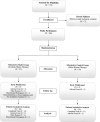Clinical effectiveness of an acellular dermal regenerative tissue matrix compared to standard wound management in healing diabetic foot ulcers: a prospective, randomised, multicentre study
- PMID: 19368581
- PMCID: PMC7951349
- DOI: 10.1111/j.1742-481X.2009.00585.x
Clinical effectiveness of an acellular dermal regenerative tissue matrix compared to standard wound management in healing diabetic foot ulcers: a prospective, randomised, multicentre study
Abstract
This 12-week, prospective, randomised, controlled multi-centre study compared the proportion of healed diabetic foot ulcers and mean healing time between patients receiving acellular matrix (AM) (study group) and standard of care (control group) therapies. Eighty-six patients were randomised into study (47 patients) and control (39 patients) groups. No significant differences in demographics or pre-treatment ulcer data were calculated. Complete healing and mean healing time were 69.6% and 5.7 weeks, respectively, for the study group and 46.2% and 6.8 weeks, respectively, for the control group. The proportion of healed ulcers between the groups was statistically significant (P = 0.0289), with odds of healing in the study group 2.7 times higher than in the control group. Kaplan-Meier survivorship analysis for time to complete healing at 12 weeks showed a significantly higher non healing rate (P = 0.015) for the control group (53.9%) compared with the study group (30.4%). After adjusting for ulcer size at presentation, which was a statistically significant covariate (P = 0.0194), a statistically significant difference in non healing rate between groups was calculated (P = 0.0233), with odds of healing 2.0 times higher in the study versus control group. This study supports the use of single-application AM therapy as an effective treatment of diabetic, neuropathic ulcers.
Figures
References
-
- Wild S, Roglic G, Green A, Sicree R, King H. Global prevalence of diabetes: estimates for the year 2000 and projections for 2030. Diabetes Care 2004;27:1047–53. - PubMed
-
- Singh H, Armstrong DG, Lipsky BA. Preventing foot ulcers in patients with diabetes. JAMA 2005; 293:217–28. - PubMed
-
- Boulton AJ, Kirsner RS, Vileikyte L. Clinical practice. Neuropathic diabetic foot ulcers. N Engl J Med 2004;351:48–55. - PubMed
-
- Houghton PE, Kincaid CB, Lovell M, Campbell KE, Keast DH, Woodbury MG, Harris KA. Effect of electrical stimulation on chronic leg ulcer size and appearance. Phys Ther 2003;83:17–28. - PubMed
-
- Meijer JW, Trip J, Jaegers SM, Links TP, Smits AJ, Groothoff JW, Eisma WH. Quality of life in patients with diabetic foot ulcers. Disabil Rehabil 2001;23:336–40. - PubMed
Publication types
MeSH terms
LinkOut - more resources
Full Text Sources
Medical





